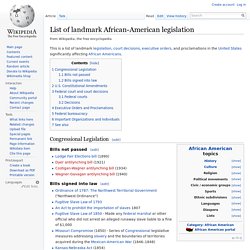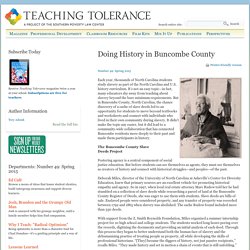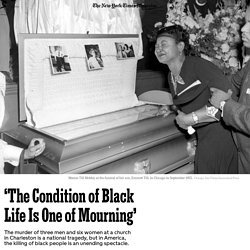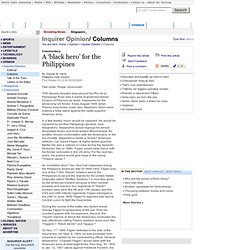

Black History Pages. The Black Past: Remembered and Reclaimed. KETK NBC. List of landmark African-American legislation. Congressional Legislation[edit] Bills not passed[edit] Bills signed into law[edit] U.S.

Constitutional Amendments[edit] Federal court and court decisions[edit] Federal courts[edit] United States Court of Appeals for the Fifth Circuit Decisions[edit] Executive Orders and Proclamations[edit] Emancipation Proclamation (1862) - Issued by President Abraham Lincoln. Federal bureaucracy[edit] Important Organizations and Individuals[edit] See also[edit] The Black innovators who elevated the United States: Reassessing the Golden Age of Invention. Contents The history of Black people’s contributions to the catalog of inventions that marked the Industrial Revolution has been largely muted.

This period is considered one of the most innovative eras in world history, seeing the birth of major advances in agriculture, transportation, communications, manufacturing, and electricity that fueled rapid economic growth. With the exception of a few notable inventors who are regularly elevated during Black History Month—e.g., George Washington Carver (peanut products) and Madam C. J. Matusevich. Diddley Bows, Cross Harps, Banjars and Backbeats: The Rhythm and Sound of Personal Agency from Southern African-America.
Was at the local “teen club” which featur ed live local music and dancing.

A few years later, it was socially acceptable to just sit or stand and listen to a “concert” but up until arou. The Oddment Emporium, Drapetomania, or the Disease Causing Negroes to... 1937-1938: Portraits of African-American former slaves. Doing History in Buncombe County. Printer-friendly version Each year, thousands of North Carolina students study slavery as part of the North Carolina and U.S. history curriculum.

It’s not an easy topic—in fact, many educators shy away from teaching about slavery beyond the bare minimum requirements. But in Buncombe County, North Carolina, the chance discovery of a cache of slave deeds led to an opportunity for students to move beyond textbooks and worksheets and connect with individuals who lived in their own community during slavery. It didn’t make the topic any easier, but it did lead to a community-wide collaboration that has connected Buncombe residents more deeply to their past and made them participants in history. 150508153031. When Sharon Moses and a group of Northern Arizona University students conduct an historical archaeology field school later this month they will be looking for relics buried beneath former slave quarters to gain additional insights on religious practices among different ethnicities and cultures.

Moses, an assistant professor of anthropology and archaeology, is investigating the site of the Hume Plantation's slave quarters on South Carolina's Cat Island, specifically looking for items related to rituals and spirituality. "I'm investigating ritual practices where slaves placed ritual magic deposits beneath their cabin floors to protect themselves from their European masters and for curative purposes," Moses said. Some slaves participated in Hoodoo practices interspersed with Christian beliefs that they had been exposed to while still in Africa. Hoodoo magic, with its Native American and European influences, involves the use of spells and homemade charms. Black History Month: Gaspar Yanga. When students learn about slavery in school, a lot of them often ask this question: “Why didn’t they fight back?”

It’s a question that often remains unanswered because lesson plans don’t always address the grittier elements of history, particularly the slave trade. But they did fight back. The Art of Kerry James Marshall. In the days following the shooting at Charleston’s Emanuel AME church, a war on words began in regards to labeling and naming the shooter.

While conservative, white media framed Dylann Storm Roof as suffering from a “mental illness,” many media journalists and activists called for the necessity of using the word “terrorist.” Artist Kerry James Marshall revisits lynching photography from the 1930s, an all-too-familiar American form of terror. These photos which were often turned into postcards that were circulated in order to spread fear and terror even farther afield, he addresses this darker and extremely relevant history with his 2002 triptych Heirlooms and Accessories.
In “Photography and Practices of Critical Black Memory,” Leigh Raiford analyzes photography and memory as a form of activism. Friends Disappear: The Battle for Racial Equality in Evanston, Barr. Black Metropolis: A Study of Negro Life in a Northern City, Drake, Cayton, Pattillo. Melvin Ely, “Israel on the Appomattox: A Southern Experiment in Black Freedom from the 1790s Through the Civil War” (Vintage Books, 2004) Freedom's Ballot: African American Political Struggles in Chicago from Abolition to the Great Migration, Garb. Crucibles of Black Empowerment: Chicago's Neighborhood Politics from the New Deal to Harold Washington, Helgeson. Retracing Boston’s African American History. ‘The Condition of Black Life Is One of Mourning’ The decision not to release photos of the crime scene in Charleston, perhaps out of deference to the families of the dead, doesn’t forestall our mourning.

But in doing so, the bodies that demonstrate all too tragically that “black skin is not a weapon” (as one protest poster read last year) are turned into an abstraction. It’s one thing to imagine nine black bodies bleeding out on a church floor, and another thing to see it. A black hero for the Philippines - INQUIRER.net, Philippine News for Filipinos. THE densely forested area around the Rio de la Pampanga River was a scene of great bloodshed.

Dozens of Filipinos lay dead, massacred by the advancing US forces. It was August 1899, when Filipino Insurrectos under Gen. Maximino Hizon were making a futile stand against the vastly superior American army. In a few weeks, Hizon would be captured. He would be replaced by another Pampango general, Jose Alejandrino. An incredible story? The 150th Anniversary of the United States Colored Troops. Today’s blog post comes from archives specialist Jackie Budell. On May 22, 1863, the War Department issued General Orders 143, establishing a Bureau of Colored Troops in the Adjutant General’s Office to recruit and organize African American soldiers to fight for the Union Army.
With this order, all African American regiments were designated as United States Colored Troops (USCT). Today marks the 150th anniversary of the USCT, and the National Archives is pleased to announce the completion of the USCT Service Records Digitization Project. In partnership with Fold3, the project provides online access to all service records—more than 3.8 million images—of Union volunteers in USCT units. From May 22 to 31, the digital collection will be free on www.Fold3.com . USN Ships - USS Mason (DE-529) USS Mason, a 1140-ton Evarts class destroyer escort, was constructed at the Boston Navy Yard, Massachusetts.

She was commissioned in March 1944 with a largely African-American enlisted complement. Mason was employed on convoy escort duties in the Atlantic and Mediterranean through the remainder of World War II. In the early post-war months, she served as a training and experimental ship. Mason decommissioned in October 1945 and was sold for scrapping in March 1947. War Department General Order 143: Creation of the U.S. Colored Troops (1863) The War Department issued General Order 143 on May 22, 1863, creating the United States Colored Troops. Slaves, freedmen: Civil War's forgotten spies - US news - Life. WASHINGTON — In the Confederate circles he navigated, John Scobell was considered just another Mississippi slave: singing, shuffling, illiterate and completely ignorant of the Civil War going on around him. Confederate officers thought nothing of leaving important documents where Scobell could see them, or discussing troop movements in front of him.
Whom would he tell? Scobell was only the butler, or the deckhand on a rebel sympathizer's steamboat, or the field hand belting out Negro spirituals in a powerful baritone. In reality, Scobell was not a slave at all. He was a spy sent by the Union army, one of a few black operatives who quietly gathered information in a high-stakes game of cat-and-mouse with Confederate spy-catchers and slave masters who could kill them on the spot. The REAL ‘Lone Ranger’ Was An African American Lawman Who Lived With Native American Indians. The real “Lone Ranger,” it turns out, was an African American man named Bass Reeves, who the legend was based upon. Perhaps not surprisingly, many aspects of his life were written out of the story, including his ethnicity.
The basics remained the same: a lawman hunting bad guys, accompanied by a Native American, riding on a white horse, and with a silver trademark. Historians of the American West have also, until recently, ignored the fact that this man was African American, a free black man who headed West to find himself less subject to the racist structure of the established Eastern and Southern states. While historians have largely overlooked Reeves, there have been a few notable works on him.
Susie King Taylor: first African American army... The Harlem Hellfighters: Fighting Racism In The Trenches Of WWI : Code Switch. Hide caption In 1917, the Harlem Hellfighters were first sent to train at Camp Whitman near Poughkeepsie, N.Y. Caanan White/Courtesy of Broadway Books Hide caption Prevented from serving alongside white U.S. soldiers, the Hellfighters instead fought in the trenches under French command.
Caanan White/Courtesy of Broadway Books Hide caption German soldiers coined the nickname "Harlem Hellfighters," which became popular in the American press after newspaper accounts of Sgt. Henry Johnson using a bolo knife to fend off German soldiers. Education & Resources - National Women's History Museum - NWHM. Digital History Sarah Remond was an African-American abolitionist, an eloquent orator, and inspiring leader – who made her first speech against slavery when she was just sixteen. Janet Sims-Wood, “Dorothy Porter Wesley at Howard University” (The History Press, 2014) Finding Forever. // Little Sarah Rector, a descendant of slaves,...
Sarah Bickford, from slave to owner of a water company. Sarah Gammon Bickford was born on Christmas Day, 1855. For almost 70 years, Lucy Parsons fought for the... Lucy Ann Stanton, the first black American woman... Image obsessed, educationforliberation: Harriet Tubman and the... Women in History. Guy w/ the F tattoo. Lewis G. Clarke: Harriet Beecher Stowe’s Forgotten Hero. Image Courtesy of Carver Gayton In the article below Seattle historian Carver Clark Gayton describes his most prominent ancestor, Lewis G.
Black nun could be the first African American to reach sainthood. The Fascinating History Behind Black Women’s Church Hat Cultural Tradition. Elizabeth Taylor Greenfield. MARIMACHO // Ethel Waters was an... - Carolynne Snowden, c. 1920s “[Snowden] billed... Denied A Stage, She Sang For A Nation. Stars of Color: Blacklisted! Classic Ladies of Color. PAUL ROBESON, a brief biography. Paul Robeson was a famous African-American athlete, singer, actor, and advocate for the civil rights of people around the world. Vintage Black Photos - The first mainstream black model, Helen Williams. Giants at Play: LIFE With Jazz Legends. Torrential, Gut-Bucket Jazz by Geoff Dyer.
9 Iconic Photographs From African American History. Remember Africville by - ONFB. UHURA’S LEGACY: Media Images and Diversity in STEM Careers « visualinquiry. What was really great about Star Trek when I was growing up as a little girl is not only did they have Lt. Olivette Miller, celebrated “swing” harpist, circa... Josephine Baker in Paris, 1940. This picture was... Nora Douglas Holt - Kansapedia. Documentary on Early U.S. Radiation Experiments on Black Children (w/Video)
Robert Weaver Becomes the First African American... ‘The Black Panthers, Revisited’ The Clayman Institute for Gender Research. BLACK HEROES OF PULP FICTION (and we don’t mean Samuel L. Jackson or Ving Rhames) The Speech That Shocked Birmingham the Day After the Church Bombing - Andrew Cohen. The Gordon Parks Foundation. Romance in black papers : Popular Romance Project. Love and legacy : Popular Romance Project.
The Negro Motorist Green Book. Drop Me Off in Harlem. Extravagant Crowd. Garnet Mimms: The Complete United Artists & Veep Singles. In Their Journey Thru Space and Time - Ok. What is a list of books about Voodoo, Vodun, fiction and nonfiction written by black people? Andros on Ballet - Raven Wilkinson. Edward Mitchell Bannister. Edward Mitchell Bannister Bio - African-American Romantic Painter Edward Mitchell Bannister. African American Photography. Tell It Like It Is: Black Independents in New York, 1968 – 1986. Race card. Protecting Racism in Theatre.
As the Met Abandons Blackface, a Look at the Legacy of African Americans in Opera. PEA Soup: Black Radical Liberalism (by Charles Mills) Harlem Nights: Eddie Murphy and the Original Gangsters of Black Comedy. High Art or Hood Film: John Singleton’s 'Boyz n the Hood' New Jack Black: Contemporary Urbanity and Blackness in New Jack City. Eastern Dragons Meet Western Tigers: Wu-Tang Clan's Debut Helped Asian Films Find a New Audience.
Randilauren: First Ladies of Rap: Women are... Alternatives to Alternatives: the Black Grrrls Riot Ignored. Book list for black girls: promoting self-love and empowering young black women. Black History Month: African Americans Who Studied Abroad. Mass Incarceration: The Silence of the Judges by Jed S. Rakoff. Where are the Black Chefs? Jackie Ormes: The First African American Woman Cartoonist - biography from University of Michigan Press. DO BLACK PEOPLE REALLY DO THIS STUFF? Manga and Anime. Journalism Diversity Pioneer Dori Maynard Dies : Code Switch. Jerry Lawson, Inventor of Modern Game Console, Dies at 70. Laura W. Murphy: Dr. Dorothy Height Told Us That It's Not a Man's Civil Rights World. Dorothy Height, Unsung Heroine of Civil Rights Era, Is Dead at 98 - Obituary (Obit)
Jeanne Theoharis: 10 Things You Didn't Know About Rosa Parks. Rosa Parks, Revisited. Freedom Riding on a Harley: The 1950s all-Black Biker Gang. East Bay Dragons Motorcycle Club: Clubhouse.